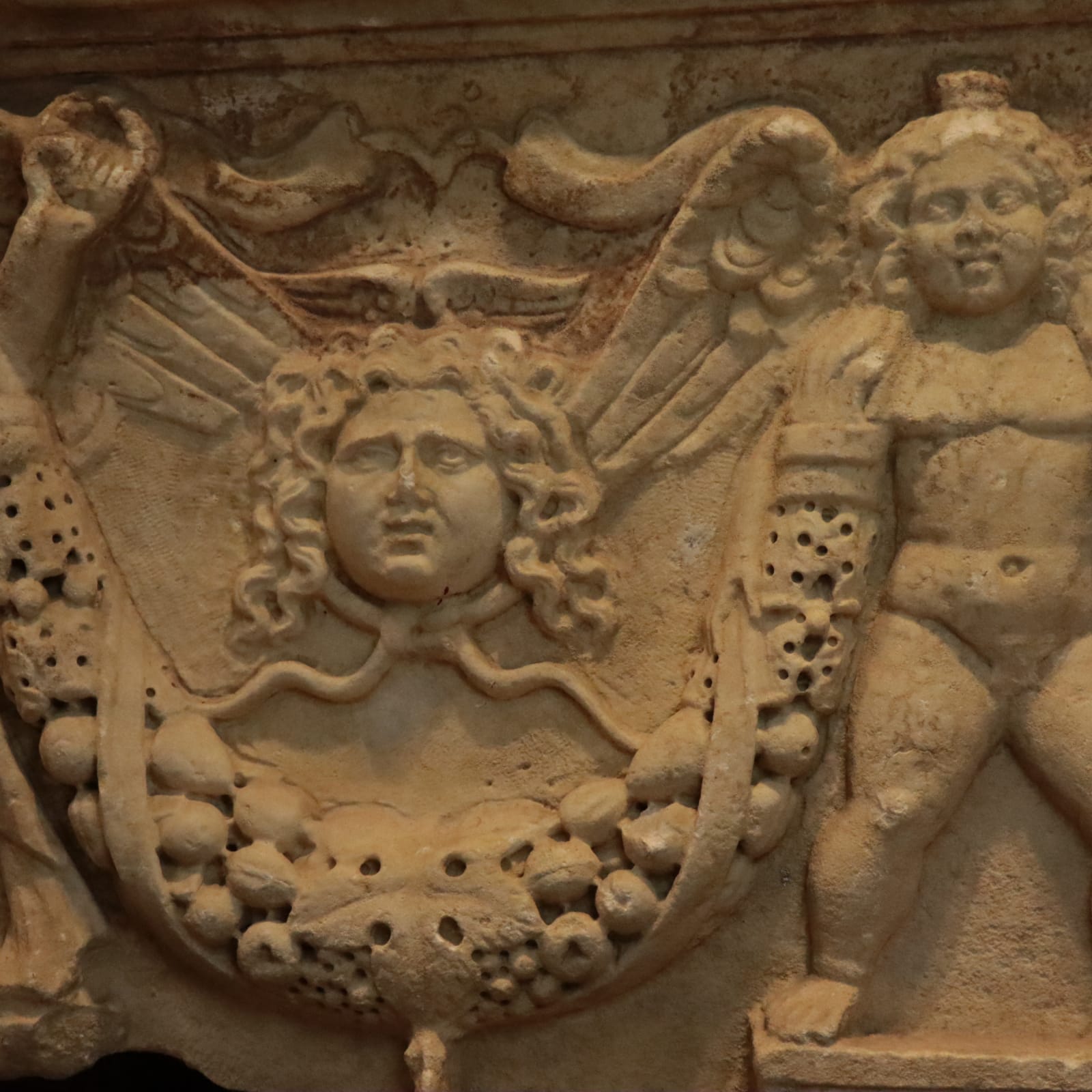Roman marble fragment of a garland sarcophagus, 2nd Century CE
Marble
85 x 87 x 12 cm
33 1/2 x 34 1/4 x 4 3/4 in
Base 102 x 33 x 16cm
33 1/2 x 34 1/4 x 4 3/4 in
Base 102 x 33 x 16cm
X.0031
Further images
This large panel of a grainy, crystalline marble belongs the front part of a garland sarcophagus, masterfully carved in high relief. Garland sarcophagi are a specific group of burial monuments...
This large panel of a grainy, crystalline marble belongs the front part of a garland sarcophagus, masterfully carved in high relief. Garland sarcophagi are a specific group of burial monuments whose principal decorative scheme is centered mostly around the swags of a large garland which were around the sarcophagus, dividing the façade into three sections.
Being able to afford a sarcophagus in death would have meant that the individual must have been extraordinarily wealthy in life. Even members of the financially robust middle classes were able to afford just cinerary urns, suggesting that the individual once deposited to rest inside this sarcophagus would have been an elite member of the Roman aristocracy. On the right side of the viewer, an Eros stands on a dado supporting the massive garland on his delicate shoulders. On the left of the fragment, the remains of a winged Victory (only her right arm and small part of her figure are preserved) is supporting the other end of the garland, offering a triumphal crown in her upraised arm. Above the swag is the frontal apparition of a Medusa head crowned by a pair of wings. In the present case Medusa appears more as an idealized human than the horrendous monster she was described to be in mythology, staring upwards with haunting eyes, and being used as a powerful “apotropaic’ symbol, an emblem serving to ward off the evil eye. The garland is composed of various fruits and acanthus leaves, with a large wine leaf placed right in the center. Suspended from this leaf is a large cluster of grapes.
The deep carving that characterizes this work of art was achieved by the expert use of a running drill, a tool that became a great favourite with sculptors during the later half of the 2nd Century A.D. The artistry of this work is quite impressive considering that it was created specifically for funerary purposes and was meant to be buried underground or at least being placed inside a vault. More than a mere coffin, this sarcophagus is a monument glorifying the life and memory of an important Roman individual.
Being able to afford a sarcophagus in death would have meant that the individual must have been extraordinarily wealthy in life. Even members of the financially robust middle classes were able to afford just cinerary urns, suggesting that the individual once deposited to rest inside this sarcophagus would have been an elite member of the Roman aristocracy. On the right side of the viewer, an Eros stands on a dado supporting the massive garland on his delicate shoulders. On the left of the fragment, the remains of a winged Victory (only her right arm and small part of her figure are preserved) is supporting the other end of the garland, offering a triumphal crown in her upraised arm. Above the swag is the frontal apparition of a Medusa head crowned by a pair of wings. In the present case Medusa appears more as an idealized human than the horrendous monster she was described to be in mythology, staring upwards with haunting eyes, and being used as a powerful “apotropaic’ symbol, an emblem serving to ward off the evil eye. The garland is composed of various fruits and acanthus leaves, with a large wine leaf placed right in the center. Suspended from this leaf is a large cluster of grapes.
The deep carving that characterizes this work of art was achieved by the expert use of a running drill, a tool that became a great favourite with sculptors during the later half of the 2nd Century A.D. The artistry of this work is quite impressive considering that it was created specifically for funerary purposes and was meant to be buried underground or at least being placed inside a vault. More than a mere coffin, this sarcophagus is a monument glorifying the life and memory of an important Roman individual.













